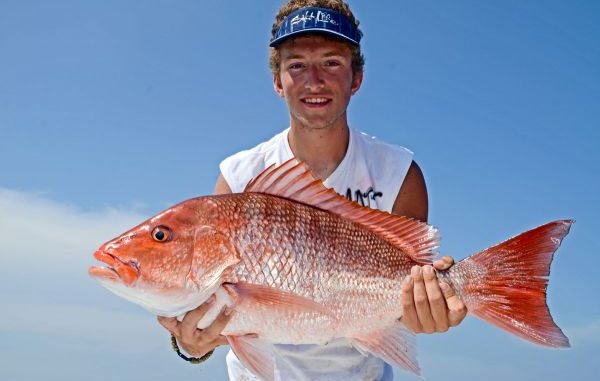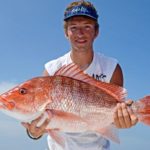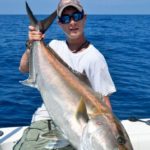
The offshore waters off the toe of Louisiana’s boot get a lot of attention, but head to the west for some exceptional rig-fishing action on everything from snapper to hard-fighting amberjacks.
“Offshore is what we do,” 46-year-old Dennis Menard Jr. said. “We have blue water in our veins. We are all intrigued by it.
“It’s the not knowing what you are going to come up with.”
After a couple of years of bouncing off of Dennis and Amanda Menard at various fishing events, I knew they were a storehouse of fishing and rigging tips.
And I knew they caught a lot of fish; family members’ names litter the official Louisiana fish records book.
But I got a lot more than I bargained for after I negotiated a trip with the couple.
First was the food, an outrageous seafood feast of crawfish étouffée over marinated fried fish, preceded by bacon shrimp wraps (See this month’s Seafood Bible column).
I quickly learned that everyone in this big, combined family cooks, fishes and hunts. Besides Amanda and Dennis Jr., that included five teenagers — 18-year-old Nichole Menard, 17-year-old Jimmie Boothe, 16-year-old Dennis Menard III, 14-year-old Jeanne Menard and 13-year-old Ryan Boothe.
That they are nuts about fishing is obvious from looking around the spacious yard of their home halfway between Abbeville and Henry, in the heart of rice and crawfish country. It had six boats in it. More than 20 rods and reels set under the patio, tuned up and ready for the next day’s fishing.
Hunting seems to be as much of an affliction as fishing. It seemed like every square foot of wall space in the big house had a rack deer mounts on it. They own a 34-foot camper trailer they haul to hunting spots in several southern states.
The morning of our offshore trip began real early. It’s a long way to deep water off western Louisiana.
Besides Amanda and Dennis, the fishing crew included Nichole and Jimmy, as well as Jimmie’s 16-year-old best friend, Matthew Suire.
Dennis III and Jeanne had other obligations, and Ryan generously elected to serve as chef and have a multi-course meal ready at home for the returning anglers at the end of what would be a long day.
They launched their 30-foot Pro Sports ProKat catamaran at a small, obscure boat launch at Freshwater City. It was 48 miles to their first stop, a towering offshore platform carrying Vermilion 191C on its sign board.
Dennis’s plan here was to let the rest of the crew chase mangrove snappers or whatever else would bite, while he caught some hardtails (aka blue runners) as bait for amberjack.
The season for keeping amberjacks was closed, but he wanted to duke it out with a couple of the hard-fighting sluggers and release them.
He grinned as he whipped out a freshwater Zebco spin-cast reel.
“You don’t often see these on offshore boats,” Dennis quipped. “They are really handy for catching bait with Sabiki rigs, and you never have to worry about backlashes. They are kid-friendly, and lots of kids like to help catch bait.”
The hardtails came in quickly in ones, twos and even threes, all of which Dennis added to the live baitwell.
Meanwhile the mangrove gang on the bow of the boat was mainly whipping up on small but legal almaco jacks.
With no mangrove snappers to hold them there, they unhooked the boat from the platform and headed farther offshore. The big cat droned on autopilot through beds of golden sargassum grass lines and water of the deepest possible shade of blue.
As the boat approached Marsh Island 72 in 142 feet of water, Dennis slowly circled the rig while watching his electronic fish finder for fish activity. He studied water current speed and direction to determine whether to tie up to the rig or use the boat’s twin motors to keep the boat in fishing position.
Tying up was the option he chose.
Dennis was determined to catch his amberjack, so he fished a hardtail from the livewell and closely clipped off the lobes of its tail fins before putting it on the hook.
“The first thing (hardtails) want to do is swim into the rig and hang up,” he explained. “We want to take that ability away.”
His Carolina-style rig was heavy —an 8-ounce (it could be more or less depending on water current strength) egg sinker and a 130-pound-test fluorocarbon leader with a 7/0 circle hook.
The others rigged for snapper.
The boat carried a variety of bait from which to choose. Dennis had stocked Spanish sardines, cigar minnows, frozen pogies, squid and bycatch from a shrimp trawler friend, Brock Miller.
Some of the bycatch was used as bait, but much was used as chum, both to lure mangrove snappers out from under rigs and to put big predator fish in a feeding mode.
Amanda, Nichole and Suire concentrated on red snappers with good results, while Dennis and Jimmie worked on amberjacks.
The snappers were more willing than the AJs. Some of them were in the upper teens, so the anglers could afford to be selective.
A few oddball species like gray triggerfish and smaller jacks were mixed in for variety, and just enough sharks — some of them impressive in size — grabbed their lines to keep things lively.
Thrashing sharks make good memories, too.
Dennis moved the boat to the upcurrent side of the platform and held it in place with its motors. The catch was the same on the first side, so he called for all lines to come up, and he bounced the boat to Marsh Island 73.
Amanda immediately hooked up on a big red snapper, followed by Nichole with another.
Boothe sent a live hardtail to the bottom, still searching for his amberjack. He had a monster hit, and Nichole strapped a fighting belt on him.
Then the line snapped.
“There’s one for the memory bank,” Boothe half-groaned, half-sighed.
Dennis decided the team had time for one last move, this one 26 miles farther offshore to Candy Mountain, what bottom charts call Sonnier Bank.
Vermilion 305 sits in 130 feet of water, surrounded by waters 200 feet deep.
Besides the ever-present red snappers, Jimmie finally got his big amberjack. After straining to pose it for the camera, he solemnly released it.
With shadows getting long and facing a 93-mile run back to land, the crew knew it was time to leave — but they obviously weren’t ready.
“Often we fish all night,” Dennis said. “By staying out overnight on the boat, we save a two- or three-hour run in and then back out again the next morning.
“Also, we can catch the early morning bite.”
“You should see us by the third day of a rodeo,” Amanda chuckled. “No one wants to get up and fish the last morning. Then the adrenaline kicks in and, on the last day, no one wants to quit.
“We fish to exhaustion. We fished on Thursday, Friday and Saturday in the Fishing for Memories Rodeo, and went to the weigh-in on Sunday. Then we cleaned fish on Monday and Tuesday, and headed out Wednesday for The Iberia Rod and Gun Club rodeo that began on Thursday and ended Saturday.
“We won places in both rodeos. After the weigh-in around 4 p.m. we decided to take a short nap before going out to eat and celebrate.
“No one woke up until the next morning.”

